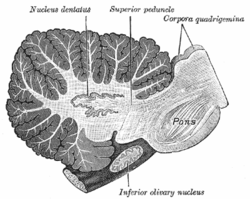Dentate nucleus
| Dentate nucleus | |
|---|---|

Sagittal section through right cerebellar hemisphere. The right olive, “inferior olivary nucleus”, has also been cut sagittally – from front to back. (Dentate nucleus, “nucleus dentatus”, labeled at top.)
|
|
| Details | |
| Part of | cerebellum |
| Artery | superior cerebellar artery |
| Identifiers | |
| Latin | nucleus dentatus |
| NeuroNames | hier-680 |
| NeuroLex ID | Dentate Nucleus |
| Dorlands /Elsevier |
n_11/12580950 |
| TA | A14.1.07.407 |
| FMA | 72260 |
|
Anatomical terms of neuroanatomy
[]
|
|
The dentate nucleus is a cluster of neurons, or nerve cells, in the central nervous system that has a dentate – tooth-like or serrated – edge. It is located within the deep white matter of each cerebellar hemisphere, and it is the largest single structure linking the cerebellum to the rest of the brain. It is the largest and most lateral, or farthest from the midline, of the four pairs of deep cerebellar nuclei, the others being the fastigial nucleus and the globose and emboliform nuclei which together are referred to as the interposed nucleus. The dentate nucleus is responsible for the planning, initiation and control of voluntary movements. The dorsal (towards the back of the body) region of the dentate nucleus contains output channels involved in motor function, which is the movement of skeletal muscle, while the ventral (towards the belly or front of the body) region contains output channels involved in nonmotor function, such as conscious thought and visuospatial function.
The dentate nucleus is highly convoluted, with gyri (ridges on the cerebral cortex) and sulci (furrows or grooves on the cerebral cortex). Its formation is coincident with a critical period of extensive growth in the fetal dentate. The dentate nucleus becomes visible in the cerebellar white matter as early as 11-12 weeks of gestation, containing only smooth lateral (towards the side(s) or away from the midline) and medial (towards the midline) surfaces. During this time, the neurons of the dentate nucleus are similar in shape and form, being mainly bipolar cells.
During 22-28 weeks of gestation, which is the critical period in fetal development of the dentate nucleus, gyral formation occurs extensively over the entire surface. Here, neurons mature into various forms of multipolar cells, and the most frequent neuronal types are medium sized to large neurons.
The architecture of cerebellum has a form that resembles the structure of a crystal, so a slice anywhere in the cerebellum gives repeated architecture. The eight cerebellar nuclei, located within the deep white matter of each cerebellar hemisphere, are grouped into pairs, with one of each pair in each of the two hemispheres. As a chunk of tissue, the dentate nucleus with overlying cerebellar cortex makes up a functional unit called the cerebrocerebellum. Thus, there is a part of cerebellum that communicates exclusively with the dentate nucleus.
...
Wikipedia
